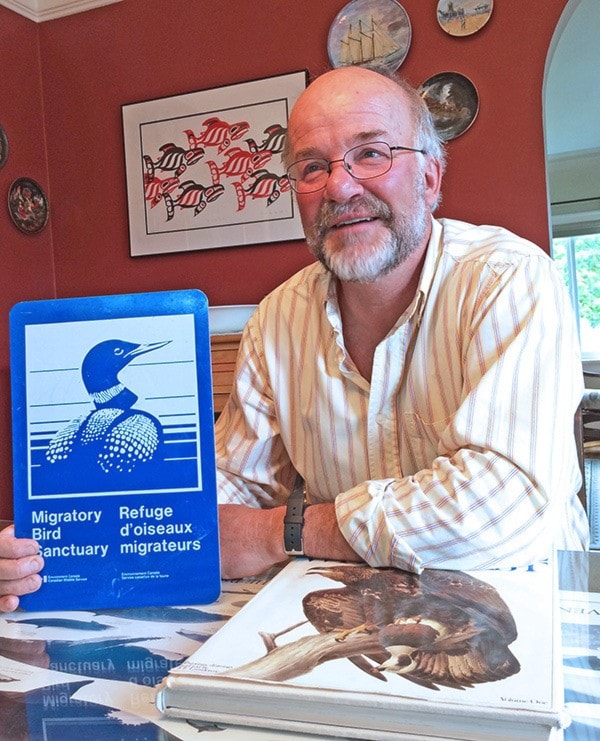Too many of us are overlooking the unique natural areas of Greater Victoria and it’s about time to stop and take notice, according to local wildlife advocate Jacques Sirois.
The retired employee who formerly worked for Wildlife Service Canada uses his kayak to cruise the shorelines from Cadboro Bay and Ten Mile Point, all the way to Portage Inlet. He spots birds of all varieties, anchovies and oysters thought to be nearly extinct from the area, all within metres of a tideline that is part of a diverse stretch of sacred waterways. It includes migratory bird nesting grounds and an estuary, and it was all captured under the federally created Greater Victoria Bird Sanctuary in 1923. But today, the health of the sanctuary is not earning its proper due.
“It’s time we revisited this sanctuary, it was created for a reason,” said Sirios, who is the chair of the Friends of the Victoria Bird Sanctuary. “It’s one of the best urban wildlife sanctuaries in Canada, and the Colquitz River is in the heart of it all.”
He even calls it, “biodiver-city.”
That includes orcas interrupting seaplane traffic in the outer harbour, seals and otters and salmons in the Gorge, and marbled murrelets in the outer harbour, Oak Bay and Caddy Bay. Or 3,000 salmon in Portage Inlet (2014).
In October, Nature Canada bestowed Sidney’s Shoal Harbour bird sanctuary with the title of NatureHood. The concept of a NatureHood is meant to inspire urban residents to connect with nature by recognizing and celebrating the wildlife habitat in urban centres with important bird and biodiversity areas.
Next on the list for a NatureHood designation is the Victoria Harbour Bird Sanctuary for its exemplary mix of wildlife in an urban setting.
“Bird sanctuaries in Victoria were originally created to stem the hunting of birds, especially the Pacific black brant,” Sirois said.
Best as we know, only about 20 brant roam at Victoria’s Clover Point, and about 100 will winter in the region. A century ago there were thousands, but because the brant makes for good eating, its local population was nearly wiped out. However, the brant’s survival and resurgence is well documented in neighbouring areas such as Washington state and Parksville/Qualicum.
What hasn’t been well documented, Sirois says, is the resurgence of other wildlife in Greater Victoria, particularly in Saanich waters.
“I talked to people in Washington state who can’t believe we still have Olympic oysters in the Gorge,” Sirois said. “Thirty years ago, the Wildlife Service was considering delisting the Victoria Harbour Bird Sanctuary because the waters were so polluted.
Thanks to the efforts of the Capital Region District, local municipalities, the Ministry of Environment, Veins of Life Watershed Society and countless volunteers from community groups, the Gorge Waterway in particular is as healthy as it’s been in 60 years, Sirios added.
However, there will be no help from Environment Canada. Riparian zones, such as the Colquitz, will not be enforced federally.
“Victoria is small fry compared to the big fish Wildlife Service is trying to deal with,” Sirios said.
To help facilitate the sanctuary’s ongoing protection, Sirois acquired a few dozen Migratory Bird Sanctuary signs from Wildlife Service that should have been posted in the sanctuary’s most sensitive areas 80 years ago, he said,
“If you total the Rock Bay soil contamination effort and other efforts over the last 30 years, it adds up to $500 million spent in the Esquimalt and Gorge waterways. Momentum is building, we have a good thing going here. Saanich has already posted three signs on the Colquitz, View Royal is interested, Oak Bay is interested.”
The new Craigflower Bridge has a wildlife sign on top of it but only now will it have the Wildlife Service signs posted underneath for paddlers. The Craigflower is a known passage for the herring which are considered a linchpin in the Salish Sea food chain. They draw humpbacks to the waters off of Sooke, seals (and therefore orcas) to the outer harbour, waterfowl and salmon to the Portage Inlet and tributaries.
